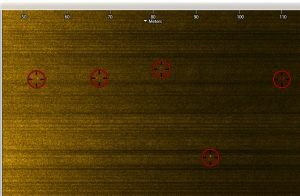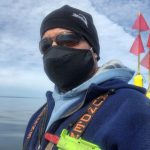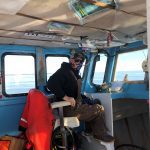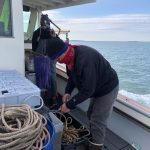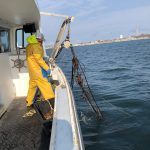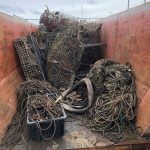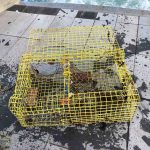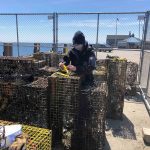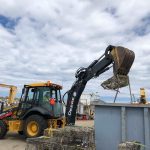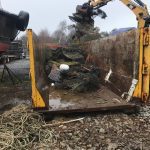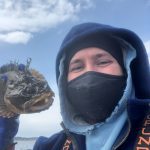June 15, 2020
Laura Ludwig, Project Manager, Co-Principal Investigator
When the pandemic settled in for good in mid-March, the ghost gear field work was just ramping up. Side scan sonar surveys had begun in February, and collaborating fishermen were readying their vessels and waiting for weather windows to grapple; in fact, just two days after Owen and Dave Seitler worked in Wellfleet, reported here earlier, the Center for Coastal Studies halted all field work operations until it could create effective safety working protocols during a very confusing time.
During the unexpected downtime, we reviewed the sonar imagery we had obtained in February in three of the targeted areas. Our success with grappling depends on good reconnaissance, so our marine geology team surveys the identified areas with side-scan sonar before we conduct any grappling exercises. The side-scan image pictured gives an idea of what the sonar can reveal in each survey area, such as lost lobster traps, which show up in the sonar imagery as small white dots.
Side-scan sonar surveys conducted in February provided information for us when we carefully re-started the field work after safety protocols were established, and with the go-ahead that the Center’s was categorized as “essential”, the first COVID-era boat headed out to the Fishing Ledges on March 28th.
- Owen Nichols, in full PPE, aboard the F/V RESOLVE
- Rob Martin, captain of the F/V RESOLVE
- Pete Mason (captain) and Kara Delaney aboard the F/V KESTREL
- Mike Rego, captain of the F/V MISS LILLY
“Going slowly and carefully at a minimum 6 foot distance apart and getting it done.”
— 3/28/20 text from Owen Nichols on the F/V RESOLVE, captained by Rob Martin.
When the debris and lobster traps come on board, data is recorded about the age and location of each trap, its condition and whether the escape vents are functioning, and whether there is any bycatch – living marine animals inadvertently captured by the trap — which is then released. (See the ling cod tucked in the trap in the photo right? He swam free soon after this photo was taken.) All this data is entered into a regional ghost gear database and we can then report on the number of lobsters, finfish, crabs, and other marine animals that were released from the traps, along with information about the size, sex and and fecundity (whether a female is egg-bearing or not) of the lobsters.
Over the month of April, three boats – Fishing Vessel (F/V) RESOLVE from Sandwich, KESTREL from Marshfield, and MISS LILLY from Provincetown — plied Cape Cod Bay, recovering over 10,000 pounds of lost traps, rope, buoys, net, cable, and monofilament in just 18 trips.
Disposing of this type of debris is challenging, but we have worked out a system with our waste handling partners over the years of conducting these cleanups to prevent thousands of pounds of fishing gear from heading to a landfill. This year, some of it was recycled, such as the broken wire traps or steel cable, and much of it was sent to an incineration plant. But many of the traps were in good, “fishable” condition, and with the help of the MA Environmental Police, we were able to identify the owners from the tags in the traps, and return them to their owners.
- Recovered gear
- ID tags still present on some traps
- Corrine Losch, CCS Americorps service member
ID tags still present in some of the traps allow us to track the owners down to return good traps (m); Corrine Losch, CCS Americorps service member, flags the traps to be returned (r).
- Provincetown Dept. of Public Works collaborates with CCS to make short work of loading gear into the container on MacMillan Pier.
- Scott Torrey, a fisherman and project supporter from Sandwich, used his excavator to crush the unfishable traps landed in Sandwich before loading them into a container for recycling. (Photo credit: Rob Martin)
We gratefully acknowledge the support and participation of our extended team on this phase of the project, all of whom operated with professionalism and with safety at the forefront: lobstermen Rob, Mike, Pete and Kara, Provincetown Harbormaster’s Office and Dept. of Public Works, Sandwich Harbormaster’s Office, our friend Scott Torrey and his excavator, Caroline and Corrine who assisted when they could, the MA Environmental Police officers and MA Division of Marine Fisheries staff who consistently support this effort with their time and consultation, and our funders, the National Fish and Wildlife Foundation.
Normally, this project would have benefited from the participation of many other players – dock workers, photographers, on-board naturalists, a contracted grappling specialist from Long Island, and others – but due to the protocols established by CCS and the state, we limited the number of people at every turn, which meant that those that were involved had a lot more to do. Without a doubt, the person with the most on his plate was my co-Investigator, Owen Nichols, without whose cheerful and constant diligence this project would have suffered. He took most of the photos you see here (unless otherwise noted), was on nearly every boat, and smiled all the while. Thanks Owen, and thank you all for your interest in our project.

Our Work
Humpback Whale Research
Right Whale Research
Marine Animal Entanglement Response
Marine Geology Department
Water Quality Monitoring Program
Marine Fisheries Research
Seal Research
Shark Research
Marine Education
Interdisciplinary
Marine Debris and Plastics Program
Marine Policy Initiative
Cape Cod Climate Change Collaborative
Publications

